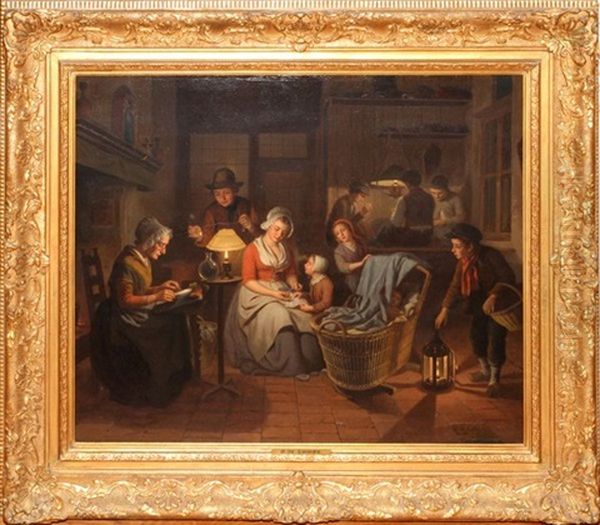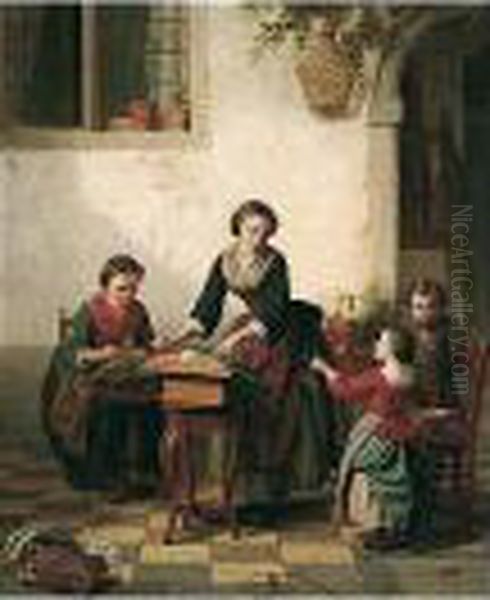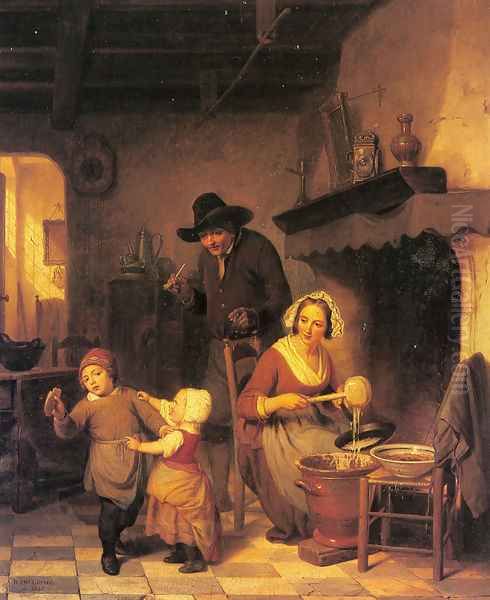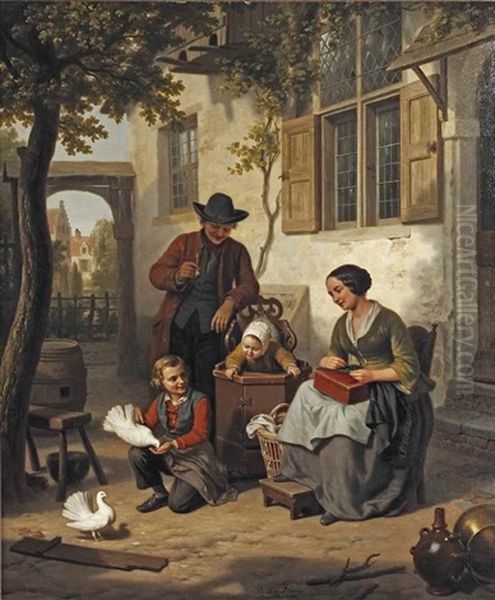
Basile de Loose stands as a notable figure in 19th-century Belgian art, an artist celebrated for his meticulously crafted genre scenes and portraits. Born in 1809 and passing away in 1885, his life spanned a period of significant change and development in European art. De Loose carved a niche for himself by focusing on the intimate moments of everyday life, particularly within the comfortable settings of bourgeois homes. His work, characterized by its detailed realism and warm sensibility, offers a valuable window into the social fabric and domestic ideals of his time, distinguishing him within a national artistic landscape rich with historical painters and emerging modernists.
Formative Years and Artistic Lineage
Basile de Loose was born in Zele, a town in East Flanders, Belgium. His artistic journey began under the tutelage of his own father, Joannes Josephus de Loose, who was himself a painter. This familial introduction to the arts provided a foundational grounding before he pursued more formal training. Like many aspiring artists of his generation in the region, he enrolled at the prestigious Royal Academy of Fine Arts in Antwerp. This institution was a crucible of artistic talent and traditional instruction, emphasizing strong drawing skills and technical proficiency.
The Antwerp Academy, during the period De Loose likely attended, was steered by influential figures such as Mattheus Ignatius van Bree, a painter known for his Neoclassical style and historical subjects. Studying in Antwerp placed De Loose within a city immensely proud of its artistic heritage, the home of Baroque giants like Peter Paul Rubens and Anthony van Dyck. While De Loose's chosen path diverged significantly from the grand scale of these masters, the environment undoubtedly instilled a deep respect for craftsmanship and painterly tradition.
The Antwerp Milieu and Early Influences

The artistic atmosphere in Antwerp during De Loose's formative years was vibrant. The recent independence of Belgium in 1830 fostered a sense of national pride, which often translated into a renewed interest in the nation's history and cultural identity. This period saw the rise of Belgian Romanticism, with painters often looking back to the country's glorious past, including the Dutch and Flemish Golden Age of the 17th century. Figures like the novelist Hendrik Conscience were simultaneously celebrating Flemish culture in literature.
While some artists embraced the dramatic flair of Romanticism, others found inspiration in the quieter, detailed realism of 17th-century masters. It was this latter tradition that would profoundly influence Basile de Loose. The meticulous techniques and domestic themes explored by Dutch painters like Gerard ter Borch and Gabriel Metsu resonated with the sensibilities of the 19th-century bourgeoisie and offered a compelling alternative to grand historical narratives. De Loose absorbed these influences, preparing to adapt them to his own contemporary context.
Parisian Exposure and Settling in Brussels
Sources suggest that De Loose spent some time in Paris around 1835. Paris was, then as now, the undisputed center of the European art world. A period spent there, however brief, would have exposed him to a wider range of artistic currents, from the established academic traditions promoted by the École des Beaux-Arts to the burgeoning Romantic movement led by artists like Eugène Delacroix. This exposure may have broadened his perspectives, even if his core style remained rooted in Flemish and Dutch traditions.
Following his time abroad, De Loose made a pivotal move, establishing himself professionally in Brussels. As the capital of the newly formed Belgian nation, Brussels was rapidly growing in importance and attracting talent from across the country and beyond. It offered a lively artistic community, exhibition opportunities through its Salons, and a growing market of patrons interested in acquiring contemporary art. It was in Brussels that De Loose would build his reputation and spend much of his productive career.
The Heart of His Oeuvre: Genre Painting
Basile de Loose dedicated his career primarily to genre painting – the depiction of scenes from everyday life. His preferred subjects were often drawn from the domestic sphere: families gathered in well-appointed interiors, quiet moments of work or leisure, interactions between parents and children. This focus aligned perfectly with the tastes of the rising middle class, who saw their own lives and values reflected in these charming, relatable scenes. The emphasis was on comfort, propriety, family bonds, and quiet diligence.

His approach stood in contrast to the large-scale historical paintings that dominated the official Salons earlier in the century, championed by leading figures of the Belgian Romantic school such as Gustave Wappers and Nicaise de Keyser. While those artists sought national glory and dramatic narratives on grand canvases, De Loose excelled in the intimate scale, finding significance in the commonplace. His work offered a sense of peace and order, a reassuring vision of domestic harmony that held wide appeal.
Echoes of the Dutch Golden Age
The most significant stylistic influence on Basile de Loose's work comes from the Dutch Golden Age painters of the 17th century, particularly the "fijnschilders" or "fine painters," renowned for their exquisite detail and refined technique. The connection is evident in his compositions, his choice of subject matter, and his meticulous rendering. One can see echoes of Gerard ter Borch in De Loose's elegant portrayal of figures and his careful attention to the textures of fabrics like silk and velvet.
Similarly, the quiet interior narratives and the sensitive depiction of light recall the work of Gabriel Metsu and Pieter de Hooch. Like these masters, De Loose often used light not just for illumination but also to create mood and draw attention to key elements within the composition. He skillfully adapted this 17th-century aesthetic, imbuing it with a 19th-century sensibility, often adding a touch more sentimentality than his Golden Age predecessors. His work represents a continuation and reinterpretation of this rich artistic lineage.
Meticulous Realism and Technical Skill
A hallmark of Basile de Loose's style is his commitment to meticulous realism. His paintings are characterized by careful drawing, a smooth, polished finish, and an extraordinary level of detail. He took great care in rendering the textures of materials – the gleam of polished wood, the softness of carpets, the intricate patterns of lace, the sheen of ceramics. This precision extended to the depiction of human figures, their facial expressions, gestures, and clothing rendered with painstaking accuracy.
This dedication to fine detail placed him alongside other Belgian artists admired for their technical prowess. Josephus Laurentius Dyckmans, a contemporary, was even nicknamed "The Antwerp Metsu" for his similarly highly finished genre scenes, demonstrating a shared appreciation for this meticulous approach. De Loose's technical skill was not merely for show; it served to enhance the sense of realism and tangibility in his scenes, inviting viewers to immerse themselves in the depicted world.
Themes of Family, Childhood, and Domesticity

The recurring themes in De Loose's work revolve around the family unit and the sanctuary of the home. He frequently depicted multi-generational families interacting within comfortable parlors or living rooms. Children are often central figures, shown playing, learning, or simply being part of the domestic tableau. Works like Interior with Family and A Family Scene in Holland (the latter now housed in the Berlin National Gallery) exemplify this focus. These paintings celebrate the virtues of family life – harmony, affection, education, and quiet enjoyment.
Women are often portrayed engaged in traditional domestic activities, such as sewing, reading, or caring for children. The Lace-Maker, a subject popular among both 17th-century Dutch artists like Caspar Netscher and 19th-century genre painters, appears in his oeuvre (a version is in the Leipzig Museum). These depictions reinforced contemporary ideals of domesticity and the separate spheres of men and women, while also showcasing the artist's skill in rendering intricate details and quiet concentration.
Narrative Charm and Anecdotal Detail
While often depicting quiet moments, De Loose's paintings frequently contain a subtle narrative element or anecdotal charm. They capture a specific instant, suggesting a story or a particular relationship between the figures. The work titled Portret van de melkmeid (Portrait of the Milkmaid), mentioned in the source material, is described as showing a young woman painting a cow, surrounded by supportive family members – a narrative celebrating artistic inclination within a domestic setting.
Another intriguing title mentioned is a special biscuit. While the exact subject is unclear without viewing the painting, the title itself suggests a small, charming anecdote – perhaps a child receiving a treat, a moment during a tea gathering, or a scene involving food preparation or enjoyment. This focus on small, relatable human moments contributed significantly to the popularity of his work, making it easily understandable and emotionally engaging for his audience. His paintings often feel like snapshots of life, imbued with warmth and gentle humor.
Handling of Light and Atmosphere
Light plays a crucial role in establishing the mood and atmosphere of De Loose's interiors. He typically employed soft, diffused light, often emanating from a window just outside the frame, reminiscent of the techniques used by Johannes Vermeer, although perhaps less complex. This light illuminates the scene gently, highlighting key figures or objects and creating subtle contrasts between light and shadow. It contributes to the overall sense of calm and intimacy that pervades his work.

His use of light differs from the dramatic chiaroscuro favored by some Romantics or the specific, often artificial, lighting effects explored by contemporaries like Petrus van Schendel, known for his moonlit scenes and candlelit market stalls. De Loose's lighting feels naturalistic and serves to enhance the realism and tranquility of his domestic environments. It bathes his subjects in a warm glow, reinforcing the feeling of the home as a comfortable and secure haven.
Documented Works and Museum Collections
Several specific works by Basile de Loose are documented in museum collections and exhibition records, confirming his activity and recognition. As mentioned, the National Gallery (Alte Nationalgalerie) in Berlin holds Scene at an Inn and A Family Scene in Holland. The Museum der bildenden Künste in Leipzig houses A Dance of Children and The Lace-Maker. The existence of these works in major German public collections speaks to his reputation beyond Belgium's borders during the 19th century.
Exhibition records also provide titles, such as Les Avantages du sommeil (The Advantages of Sleep), shown in an 1867 exhibition. Auction records mention works like Interior with Family. While titles like a special biscuit remain somewhat enigmatic without further visual or descriptive information, the documented presence of numerous works across collections and exhibitions solidifies his standing as a productive and recognized artist of his era.
Exhibition Success and International Recognition
Basile de Loose actively participated in the official art Salons held regularly in Brussels, Antwerp, and possibly Ghent. These Salons were the primary venues for artists to exhibit their work, gain critical attention, and attract patrons. His consistent production of appealing genre scenes likely ensured his regular inclusion in these prestigious exhibitions. The detailed finish and relatable subject matter of his paintings would have resonated well with Salon juries and the public alike.
A significant mark of recognition was his inclusion in the Belgian art section of the Centennial International Exhibition held in Philadelphia in 1876. This major world's fair aimed to showcase industrial and cultural achievements from around a globe. Having his work selected for the official Belgian contribution demonstrated his established reputation and the esteem in which his art was held. It introduced his detailed genre style to a large American audience, contributing to the international appreciation of Belgian art.
Market Appeal and Collector Interest
The accessible themes and meticulous execution of De Loose's paintings made them highly desirable in the 19th-century art market. Patrons appreciated the craftsmanship, the depiction of comfortable bourgeois life, and the often sentimental or charming narratives. The reference in the source material to an Interior with Family fetching between $5000 and $8000 at auction (though the date of the auction is unspecified) indicates a solid market value for his work among collectors specializing in 19th-century European painting.
This market appeal reflects a broader taste during the period for genre scenes that were both technically accomplished and emotionally resonant. Artists like De Loose catered to a demand for art that was decorative, understandable, and affirmed the social values of the time. His success demonstrates the viability of specializing in this type of intimate genre painting, even alongside the more dominant trends of historical painting or, later, Realism and Impressionism.
Context within 19th-Century Belgian Art
To fully appreciate Basile de Loose's contribution, it's helpful to place him within the context of his Belgian contemporaries. His focus on detailed, often Biedermeier-influenced genre scenes aligns him with artists like Ferdinand de Braekeleer the Elder, who also painted historical and domestic subjects with careful attention to detail, and Jean Baptiste Madou, known for his lively, often humorous scenes of everyday life, frequently reproduced as popular lithographs. David Col was another contemporary working in a similar vein of anecdotal genre.
His style differs markedly from the heroic Romanticism of Wappers or De Keyser, and also from the later, more robust historical realism of Henri Leys, who also looked to the past but with a different intensity. De Loose also stands apart from the emerging social realism of artists like Constantin Meunier, who focused on the lives of industrial workers, or the elegant depictions of modern society life painted by Alfred Stevens. De Loose occupied a specific, popular niche focused on traditional craftsmanship and intimate domesticity. Charles Baugniet, primarily a portraitist, also produced genre scenes that shared some of De Loose's polish and charm.
Wider European Connections
While deeply rooted in Belgian and Dutch traditions, De Loose's work can be seen in relation to broader European artistic trends of the mid-19th century. His meticulous technique and small-scale narratives bear comparison to the work of French academic painters like Ernest Meissonier, who specialized in highly detailed historical genre scenes, albeit often with military or 17th-century themes. Meissonier's international fame demonstrated the widespread appreciation for such virtuoso realism.
The Biedermeier sensibility evident in De Loose's work – the emphasis on domesticity, family, sentiment, and middle-class comfort – was a powerful cultural current across German-speaking lands and Scandinavia during the first half of the 19th century. Painters like Carl Spitzweg in Germany captured intimate, sometimes quirky, aspects of everyday life, sharing with De Loose a focus on the small scale and the anecdotal, though often with a greater degree of gentle satire than found in the Belgian artist's work.
Legacy and Artistic Assessment
Basile de Loose was not an avant-garde innovator who radically changed the course of art history. He did not challenge artistic conventions in the way that Gustave Courbet did with Realism, or the Impressionists would later do with their studies of light and modern life. Instead, his contribution lies in his mastery within a specific, well-established tradition: the detailed, realistic depiction of genre scenes, particularly domestic interiors. He excelled at this, creating works of high technical quality and considerable charm.
His legacy is that of a skilled chronicler of Belgian bourgeois life in the mid-19th century. He successfully adapted the techniques and spirit of the 17th-century Dutch and Flemish masters to suit the tastes and values of his own time. His paintings offer a comforting, idealized glimpse into the domestic world of his era, rendered with a precision and warmth that continues to appeal to collectors and admirers of 19th-century European art. He represents a significant and popular current within the diverse artistic production of his time.
Conclusion: A Master of Intimate Realism
In conclusion, Basile de Loose (1809-1885) holds a secure place in the history of Belgian art as a master of intimate genre painting. Nurtured by family tradition and honed at the Antwerp Academy, he developed a distinctive style characterized by meticulous realism, drawing heavily on the legacy of the Dutch Golden Age masters like Metsu and Ter Borch. Settling in Brussels, he built a successful career depicting the quiet moments of domestic life – family gatherings, children at play, women engaged in tranquil activities – all rendered with remarkable detail and a warm, often sentimental, atmosphere. While not a revolutionary figure, his technical skill, his participation in major exhibitions including the Philadelphia Centennial, and the enduring appeal of his charming scenes solidify his importance. Basile de Loose remains a key artist for understanding the values, tastes, and everyday life of the Belgian bourgeoisie in the heart of the 19th century.